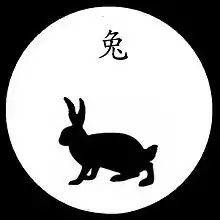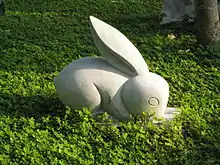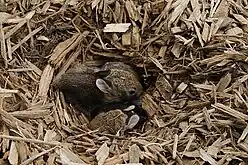| Rabbit | |||||||||||||||||||||||||||||||
|---|---|---|---|---|---|---|---|---|---|---|---|---|---|---|---|---|---|---|---|---|---|---|---|---|---|---|---|---|---|---|---|
.svg.png.webp) "Hare" in regular Chinese characters | |||||||||||||||||||||||||||||||
| Chinese | 兔 | ||||||||||||||||||||||||||||||
| |||||||||||||||||||||||||||||||

Zodiac Hare, showing the tù (兔) character for Hare
The rabbit (兔) is the fourth in the twelve-year periodic sequence (cycle) of animals that appear in the Chinese zodiac related to the Chinese calendar. The Year of the Rabbit is associated with the Earthly Branch symbol 卯.[1] the element Wood in Wuxing theory and within Traditional Chinese medicine the Liver Yin and the emotions and virtues of kindness and hope.[1][2]
In the Vietnamese zodiac and the Gurung zodiac, the cat takes the place of the rabbit.[3] In the Malay zodiac, the mousedeer takes the place of the rabbit.[4]
Years and elements
People born within these date ranges can be said to have been born in the "Year of the Rabbit", while also bearing the following elemental sign:[5][6]

White Hare figure in stone.
| Start date | End date | Heavenly branch |
|---|---|---|
| 29 January 1903 | 15 February 1904 | Water Hare |
| 14 February 1915 | 3 February 1916 | Wood Hare |
| 2 February 1927 | 22 January 1928 | Fire Hare |
| 19 February 1939 | 7 February 1940 | Earth Hare |
| 6 February 1951 | 26 January 1952 | Metal Hare |
| 25 January 1963 | 12 February 1964 | Water Hare |
| 11 February 1975 | 30 January 1976 | Wood Hare |
| 29 January 1987 | 16 February 1988 | Fire Hare |
| 16 February 1999 | 4 February 2000 | Earth Hare |
| 3 February 2011 | 22 January 2012 | Metal Hare |
| 22 January 2023 | 9 February 2024 | Water Hare |
| 8 February 2035 | 27 January 2036 | Wood Hare |
| 26 January 2047 | 13 February 2048 | Fire Hare |
| 11 February 2059 | 1 February 2060 | Earth Hare |
| 31 January 2071 | 18 February 2072 | Metal Hare |
| 17 February 2083 | 5 February 2084 | Water Hare |
| 5 February 2095 | 24 January 2096 | Wood Hare |

A nest containing baby Rabbits
Basic astrological associations
| Earthly branch: | Tree |
| Element: | Wood |
| Yin Yang: | Yin |
| Lunar month: | Second |
| Lucky numbers: | 3, 6, 9 |
| Lucky flowers: | Plantago, lily, nerve plant, snapdragon |
| Lucky colors: | Black, pink, purple, blue, grey, red; Avoid: brown, yellow, white |
| Season: | Spring |
See also
References
- 1 2 Duveen, Joan (2022). Applying Stems and Branches Acupuncture in Clinical Practice. JESSICA KINGSLEY PUBLISHERS. ISBN 9781787753709.
- ↑ van Kervel, Peter C (2012). Celestial Stems & Terrestrial Branches, Wu Yun Liu Qi : the Philosophy & Physiology of Acupuncture. Lan Di Press. ISBN 9789079212033.
- ↑ "Tamu (Gurung) Losar Festival". ECS Nepal. 11 July 2010. Retrieved 9 June 2017.
- ↑ Farouk Yahya (2015). "Glossary". Magic and Divination in Malay Manuscripts. Brill. pp. 296–306. ISBN 978-90-04-30172-6.
- ↑ "When is Chinese New Year?". pinyin.info. Retrieved 13 March 2018.
- ↑ "Chinese Zodiac – Rabbit (Hare)". Your Chinese Astrology. Retrieved 13 March 2018.
External links
 Media related to Rabbit (zodiac) at Wikimedia Commons
Media related to Rabbit (zodiac) at Wikimedia Commons
This article is issued from Wikipedia. The text is licensed under Creative Commons - Attribution - Sharealike. Additional terms may apply for the media files.